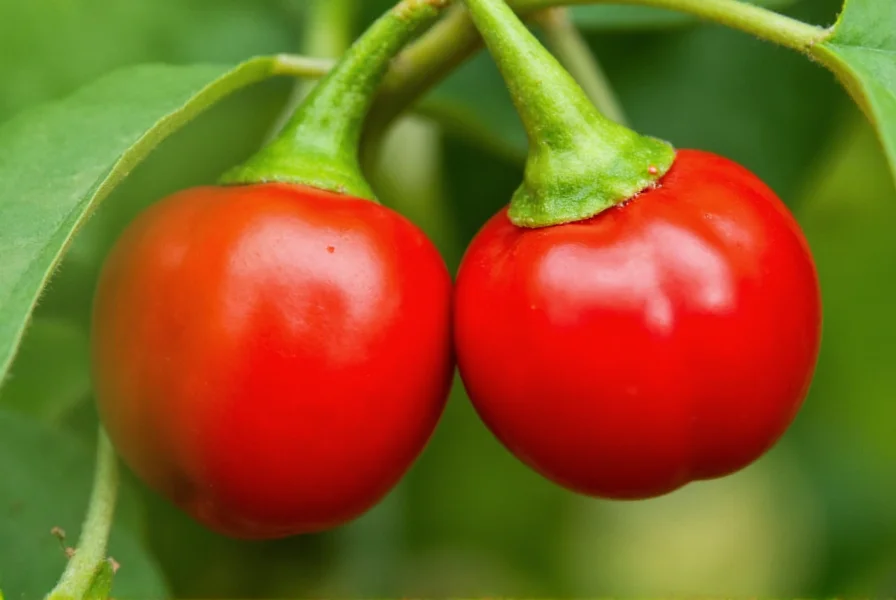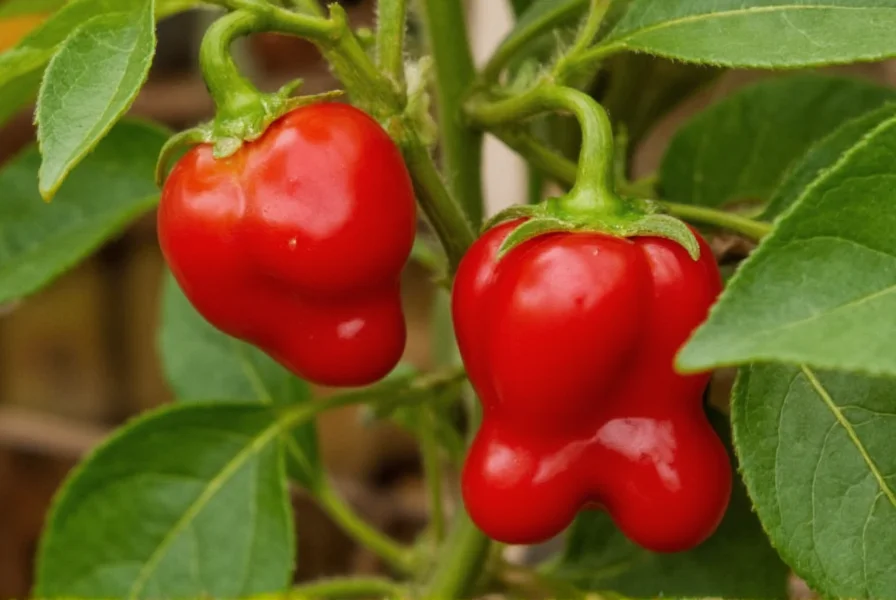Cherry hot peppers represent one of the most visually appealing and versatile varieties in the Capsicum family. These distinctive round peppers have gained popularity among home gardeners and culinary enthusiasts for their unique appearance and balanced flavor profile. Unlike their elongated counterparts, cherry peppers maintain a spherical shape throughout their growth cycle, resembling actual cherries in both form and size.
Botanical Classification and Origins
Cherry hot peppers belong to the Solanaceae family, sharing lineage with tomatoes, eggplants, and bell peppers. The specific variety Capsicum annuum var. annuum has been cultivated for centuries, with origins tracing back to Central and South America. While many pepper varieties have been selectively bred for specific traits, cherry hot peppers maintain characteristics closer to their wild ancestors than many modern hybrids.
| Characteristic | Details |
|---|---|
| Scientific Name | Capsicum annuum var. annuum |
| Typical Size | 1-2 inches in diameter |
| Color Progression | Green → Yellow → Orange → Bright Red |
| Heat Level (SHU) | 5,000-10,000 Scoville Heat Units |
| Maturity Time | 70-90 days from transplanting |
Physical Characteristics and Heat Profile
Cherry hot peppers develop as perfectly round or slightly oval fruits with smooth, glossy skin. When immature, they appear green, gradually transitioning through yellow and orange stages before reaching their final vibrant red hue. The thick walls of these peppers make them particularly suitable for stuffing and pickling applications.
The heat level of cherry hot peppers falls firmly in the medium category on the Scoville scale. At 5,000-10,000 SHU, they provide noticeable warmth without overwhelming heat—approximately two to five times hotter than standard jalapeños but significantly milder than habaneros. What distinguishes cherry hot peppers is their complex flavor profile: an initial sweet, almost fruity taste followed by a gradual build of heat that peaks and then subsides relatively quickly.

Culinary Applications and Flavor Pairings
Chef-recommended uses for cherry hot peppers leverage their unique spherical shape and balanced heat. Their size and form make them ideal for:
- Stuffed preparations with cheese, grains, or meat mixtures
- Pickling whole for condiments and antipasto platters
- Adding to salsas for visual appeal and moderate heat
- Roasting and blending into sauces and hot pepper jellies
- Using fresh in salads for pops of color and flavor
The sweet-heat balance of cherry hot peppers pairs exceptionally well with complementary flavors. Consider combining them with:
- Creamy elements like goat cheese or cream cheese to counterbalance heat
- Sweet ingredients such as honey, mango, or pineapple for contrast
- Acidic components like lime juice or vinegar to enhance brightness
- Rich proteins including pork, duck, or fatty fish to mellow the heat
Growing Cherry Hot Peppers Successfully
For gardeners interested in cultivating cherry hot peppers, these plants require similar conditions to other Capsicum varieties but with some specific considerations. Cherry hot peppers thrive in warm climates with full sun exposure (minimum 6-8 hours daily) and well-draining soil with a pH between 6.0-7.0.
Start seeds indoors 8-10 weeks before the last expected frost, maintaining soil temperatures around 75-85°F for optimal germination. Transplant seedlings outdoors after nighttime temperatures consistently remain above 55°F. Space plants 18-24 inches apart to ensure adequate air circulation, which helps prevent fungal diseases.
Water consistently but avoid overwatering, as cherry hot peppers prefer slightly drier conditions once established. Apply a balanced fertilizer every 3-4 weeks during the growing season. The plants typically reach 18-24 inches in height and produce abundant fruit when properly cared for.
Harvesting and Storage Techniques
Harvest cherry hot peppers when they've reached their final color (usually bright red) and feel firm to the touch. Use sharp scissors or pruning shears to cut the peppers from the plant, leaving a small stem attached. This prevents damage to the plant and extends shelf life.
For short-term storage, place unwashed peppers in a perforated plastic bag in the refrigerator's crisper drawer, where they'll stay fresh for 2-3 weeks. For longer preservation:
- Freeze whole peppers on a baking sheet before transferring to freezer bags
- Pickle in vinegar brine for 6+ months of shelf stability
- Dry using a food dehydrator or string them for ristra-style air drying
- Roast and freeze in olive oil for convenient cooking use
Nutritional Benefits and Health Considerations
Like other chili peppers, cherry hot varieties contain capsaicin—the compound responsible for their heat—which offers several potential health benefits. These peppers are excellent sources of:
- Vitamin C (providing over 100% of daily needs per serving)
- Vitamin A in the form of beta-carotene
- Vitamin B6 and potassium
- Dietary fiber
- Antioxidants including flavonoids and carotenoids
Research suggests capsaicin may support metabolism, reduce inflammation, and provide pain relief when used appropriately. However, individuals with sensitive digestive systems should consume cherry hot peppers in moderation, starting with small amounts to assess tolerance.
Differentiating Cherry Hot Peppers from Similar Varieties
Many gardeners confuse cherry hot peppers with other small, round varieties. Key distinctions include:
- Cherry Bomb peppers: Larger (2-3 inches), milder heat (0-5,000 SHU), primarily used for stuffing
- Fish peppers: Elongated shape despite the name, higher heat (30,000 SHU), distinctive white streaking
- Chiltepin peppers: Much smaller (pea-sized), significantly hotter (50,000-100,000 SHU), wild-growing variety
- Pepperoncini: Longer and more tapered, very mild (100-500 SHU), typically pickled
Understanding these differences helps gardeners select the appropriate variety for their culinary needs and growing conditions. Cherry hot peppers occupy a unique niche with their perfect spherical shape, medium heat level, and sweet-heat flavor profile.
Common Questions About Cherry Hot Peppers
How hot are cherry hot peppers compared to other common varieties?
Cherry hot peppers measure between 5,000-10,000 Scoville Heat Units (SHU), placing them in the medium-hot category. They're approximately 2-5 times hotter than jalapeños (2,500-8,000 SHU) but significantly milder than cayenne peppers (30,000-50,000 SHU) or habaneros (100,000-350,000 SHU). Their heat builds gradually with a sweet finish, making them more approachable than many other hot peppers.
Can I grow cherry hot peppers in containers?
Yes, cherry hot peppers grow exceptionally well in containers. Choose a pot at least 12 inches in diameter with adequate drainage. Use a high-quality potting mix rather than garden soil, and position the container where it will receive 6-8 hours of direct sunlight daily. Container-grown plants require more frequent watering and feeding than garden-planted peppers, but they often produce abundant yields and can be brought indoors during colder months in temperate climates.
What's the best way to reduce the heat of cherry hot peppers in cooking?
To reduce the heat of cherry hot peppers while preserving flavor, remove the white pith and seeds where capsaicin concentration is highest. Cooking methods also affect heat perception—roasting or baking peppers can mellow their heat, while raw applications deliver maximum spiciness. Pairing with dairy products (like yogurt or cheese), sweet ingredients, or acidic components (such as lime juice) helps balance the heat. For stuffed pepper applications, blanching the whole peppers briefly in boiling water before stuffing can reduce overall heat intensity.
How do I know when cherry hot peppers are ready to harvest?
Cherry hot peppers are ready for harvest when they've reached their full color (typically bright red, though some varieties may be yellow or orange) and feel firm when gently squeezed. The skin should be glossy rather than dull. Most varieties take 70-90 days from transplanting to reach maturity. You can harvest them earlier when green, but they'll be milder and less sweet. For maximum heat and sweetness, wait until they've fully ripened to their final color on the plant.











 浙公网安备
33010002000092号
浙公网安备
33010002000092号 浙B2-20120091-4
浙B2-20120091-4